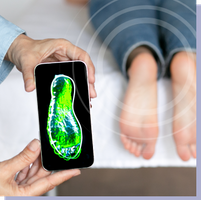Chronic pain in children
Chronic pain is a condition that affects many people, but it is not just adults who suffer. Children can also experience chronic pain, and it can have a significant impact on their lives. This section will provide an overview of chronic pain in children, its prevalence, and the importance of treating it.
Chronic pain is pain that lasts longer than three months. It can occur in any part of the body and can be caused by a variety of factors, including injuries, illnesses, or even stress and anxiety. Unlike adults, children may not be able to clearly express their pain, making it challenging for parents and doctors to understand and treat.
Chronic pain is more common than you might think. According to a study published in the journal Pain, an estimated 20-35% of children and adolescents worldwide experience chronic pain. The most common types of chronic pain in children are headaches, stomachaches, and musculoskeletal pain.
Chronic pain can have a significant impact on a child’s life. It can lead to missed school days, difficulty participating in social and physical activities, and even depression and anxiety. Therefore, it is essential to treat chronic pain promptly. Early intervention can help prevent it from affecting a child’s quality of life.
In the following sections, we will delve deeper into understanding chronic pain, its causes, symptoms, and how it can be treated. We aim to provide you with comprehensive information to help you support a child dealing with chronic pain.
What is chronic pain?
Chronic pain is a complex health issue that can be difficult to understand, especially for children. However, with the right information, we can learn to manage it effectively.
Definition of Chronic Pain: Chronic pain is a type of pain that lasts for a long period of time, usually more than three months. Unlike other types of pain, chronic pain continues even after the injury or illness that caused it has healed. It can affect any part of the body and can vary in intensity, from mild to severe. Chronic pain can be continuous or intermittent, meaning it can come and go.
The difference between acute and chronic pain: Acute pain is a normal sensation that alerts us to a potential injury. It begins suddenly and is usually sharp in quality. It serves as a warning of illness or a threat to the body. Acute pain can be caused by many events or circumstances, including surgery, broken bones, dental procedures, burns or cuts, labor, and childbirth. Acute pain may be mild and last only a moment, or it may be severe and last for weeks or months. In contrast, chronic pain lasts longer than acute pain and is resistant to most medical treatments. It can—and often does—cause serious problems for patients. A clear understanding of these two types of pain will help us treat them effectively.
Understanding chronic pain is the first step towards treating it. In the following sections, we will explore how chronic pain manifests in children and adults, its causes, symptoms, and how it can be effectively managed.
Chronic pain is a complex issue that affects both children and adults. However, the way it is expressed and perceived can differ significantly between these two groups. Let’s explore these differences.
How chronic pain manifests itself in children
Children may not always be able to express their pain as clearly as adults. They may use different words or behaviors to show that they are in pain. For example, a child may become more needy, change their sleeping or eating habits, or begin to avoid activities they usually enjoy. In some cases, children may even act normally despite their pain, which can make it difficult to identify.
Children may not express their pain in ways that adults recognize. Adults sometimes mistakenly believe that children do not experience chronic pain. This misconception can lead to delays in diagnosis and treatment. Finally, children’s pain may be expressed as “growing pains” or viewed as an attempt to avoid school or other responsibilities.
Understanding these differences is important to ensure that children with chronic pain get the help they need. By being aware of the unique ways that children express and experience pain, we can better support them.
Causes of chronic pain in children
Chronic pain in children often involves injuries, illnesses, or conditions that affect the body’s structure or function. For example, juvenile arthritis, a condition that causes inflammation in the joints, can lead to chronic pain. Other physical causes may include nerve damage, genetic disorders, or complications from surgery. According to the American Academy of Pediatrics, about 20 percent of children suffer from chronic physical pain.
Psychological causes of chronic pain in children
Psychological factors can also contribute to chronic pain in children. Stress, anxiety, and depression can heighten the perception of pain and make it harder for a child to cope. A study published in the Journal of Pediatric Psychology found that children with chronic pain are four times more likely to have anxiety or depression than their peers without chronic pain.
Environmental factors contributing to chronic pain in children
Environmental factors such as a child’s home, school, or social environment can also contribute to chronic pain. For example, a child who lives in a stressful home environment or experiences bullying at school may develop chronic pain in response to these stressors. Furthermore, exposure to toxins or pollutants in the environment can also lead to chronic pain conditions.
In conclusion, chronic pain in children is a complex issue. By understanding the causes, parents, caregivers, and professionals can work together to develop effective strategies for treating children with chronic pain.
Symptoms of chronic pain in children
Chronic pain in children is a complex condition that can have a profound impact on a child’s life. It is essential to identify the symptoms early to provide the necessary support and treatment. Symptoms can be categorized into three main areas: physical, emotional, and behavioral.
Physical symptoms of chronic pain in a child
Physical symptoms are often the first signs of chronic pain in children. These may include:
Consistent pain that lasts more than three months.
Pain that interferes with daily activities.
Unexplained pain, often described as a constant dull ache.
Difficulty sleeping due to discomfort.
Decreased appetite or significant changes in eating habits.
Chronic pain can also affect a child’s emotional well-being. Parents and caregivers should be aware of the following symptoms:
Increased irritability or mood swings.
Feelings of sadness or depression.
Increased worry or anxiety about the pain.
Feelings of hopelessness or helplessness from the pain.
Chronic pain can lead to changes in a child’s behavior. These may include:
Withdrawal from social activities.
Decreased participation in physical activity.
Changes in school performance or attendance.
Increased use of electronic devices as a distraction from pain.
Recognizing these symptoms is the first step toward treating chronic pain in children. It is important to consult a professional if you notice any of these symptoms in your child. Early intervention can significantly improve the quality of life for children living with chronic pain.
Chronic pain in children can be a challenging condition to treat. However, with the right medical treatments, pain can be relieved and the child’s quality of life can be improved. Let’s look at some of the available medical treatment options:
Medical treatments for chronic pain in children can be broadly classified into two categories: medications and surgical interventions. Each of these options has its own benefits and risks, and the choice of treatment depends on the child’s specific condition and needs.
Drug options for chronic pain relief
Medication is often the first line of treatment for chronic pain in children. The type of medication prescribed depends on the nature and severity of the pain. Over-the-counter painkillers such as acetaminophen and ibuprofen can be effective for mild to moderate pain. For more severe pain, doctors may prescribe stronger medications such as opioids. However, they are used with caution because of the risk of addiction. Other medications such as antidepressants and anticonvulsants can also be used to treat chronic pain, especially if it is related to nerve damage.
Surgical interventions for the treatment of chronic pain in children
In some cases, when medication and other noninvasive treatments are ineffective, surgical interventions may be considered. The type of surgery will depend on the underlying cause of the pain. For example, if the pain is due to a herniated disc, a discectomy may be performed to remove the disc and relieve pressure on the nerve. In other cases, a procedure called a nerve block may be performed, in which medication is injected directly into the nerves to block pain signals. It is important to note that surgery is usually considered a last resort, due to the risks and potential complications involved.
In summary, treating chronic pain in children involves a combination of medication and, in some cases, surgical interventions. The goal of treatment is not only to relieve pain, but also to improve the child’s overall quality of life. Always consult a professional to determine the best course of treatment for your child’s specific condition.
Non-medical treatments for chronic pain in a child
While medications and surgery are effective solutions, non-medical treatments can also play a crucial role. We will explore some of these options.
Physiotherapy for children with chronic pain
Physical therapy is a noninvasive approach that can help children with their chronic pain. This includes exercises that strengthen muscles, improve flexibility, and improve overall body function. For example, a child with chronic back pain may benefit from exercises that strengthen their core muscles. According to the American Physical Therapy Association, physical therapy can reduce pain and improve physical function in children with chronic pain.
Psychological interventions for the treatment of chronic pain in children
Chronic pain can take a toll on a child’s mental health, leading to feelings of frustration, sadness, and even depression. Psychological interventions, such as cognitive behavioral therapy (CBT), can help children cope with these feelings. CBT teaches children strategies for coping with their pain, such as relaxation techniques and positive thinking. A study published in the Journal of Pediatric Psychology found that CBT can significantly reduce pain intensity and improve quality of life for children with chronic pain.
Alternative treatments for chronic pain relief in children
Alternative therapies, such as acupuncture, massage, and yoga, can also help with chronic pain in children. These therapies can help reduce pain intensity, improve sleep, and improve overall well-being. For example, a study in the Journal of Pain Research found that yoga can significantly reduce pain and improve physical function in children with chronic pain. However, it is important to consult a doctor before starting any alternative treatment.
In conclusion, various treatments can be an effective part of a comprehensive chronic pain management plan for children. They can help reduce pain, improve physical function, and enhance overall well-being. However, it is important to consult with a specialist to tailor the best treatment plan for each child.
Coping with chronic pain in children
Chronic pain can be a challenging experience for children. It is essential to understand how to support them effectively. There are several ways to help your child cope with chronic pain.
Supporting a child with chronic pain involves understanding their feelings and creating a comfortable environment for them. Here are some strategies:
How to Communicate with a Child Who Experiences Chronic Pain: Open and honest communication is essential when dealing with a child who is in pain. Encourage them to express their feelings. Use simple, clear language that they can understand. For example, you can ask, “Can you show me where it hurts?” or “Can you tell me what the pain feels like?” This can help them feel understood and less afraid.
Creating a supportive environment for children with chronic pain: A supportive environment can make a significant difference in a child’s ability to cope with chronic pain. Make sure their environment is calm and comfortable. Encourage activities that they enjoy and can participate in without making their pain worse. This could include reading, drawing, or listening to music. A regular routine can also provide a sense of stability and control.
Remember, every child is unique. What works for one may not work for another. It is important to be patient, empathetic, and flexible in your approach.
Learning pain management skills
One of the most effective ways to help children cope with chronic pain is to teach them pain relief techniques. This can include techniques such as deep breathing, progressive muscle relaxation, and guided imagery. For example, deep breathing can help reduce stress and tension, which can often make pain worse. Muscle relaxation involves stretching and then relaxing different muscle groups, which can help relieve pain. Guided imagery is a technique in which the child is guided to imagine a peaceful, relaxing scene, which can help distract them from their pain.
Helping children maintain a positive outlook despite chronic pain
It is essential to help children maintain a positive outlook despite their chronic pain. This can include encouraging them to focus on the things they can do rather than what they can’t, and celebrating their achievements, no matter how small. This can also include helping them find enjoyable activities they can participate in, even if they are in pain. For example, they may enjoy drawing, reading, or playing a musical instrument.
Remember, it is important to consult a professional for personalized advice and treatment options.
Hope for children with chronic pain
In conclusion, it is important to remember that there is hope for children suffering from chronic pain. Significant advances have been made in the treatment of chronic pain in children, and research continues to pave the way for more effective treatments.
Over the past few years, the medical community has made significant strides in understanding and treating chronic pain in children. New treatments, such as cognitive behavioral therapy (CBT), physical therapy, and even alternative therapies like acupuncture, have shown promising results in treating the condition. These treatments aim to reduce pain, improve function, and improve the child’s overall quality of life.
For example, a 2019 study found that children who underwent CBT experienced significant reductions in their pain levels and improvements in their daily activities. This is just one example of how advances in chronic pain treatment are providing hope for children and their families.
While we have made progress, there is still much to learn about chronic pain. Continued research is essential in our journey to understand the complexities of chronic pain and develop more effective treatments. Every new study brings us one step closer to a future where no child has to live with untreatable pain.
In conclusion, while chronic pain can be a challenging condition for children and their families, there is hope. With continued advances in treatment and a commitment to further research, we are moving toward a future where every child has access to effective treatment.









